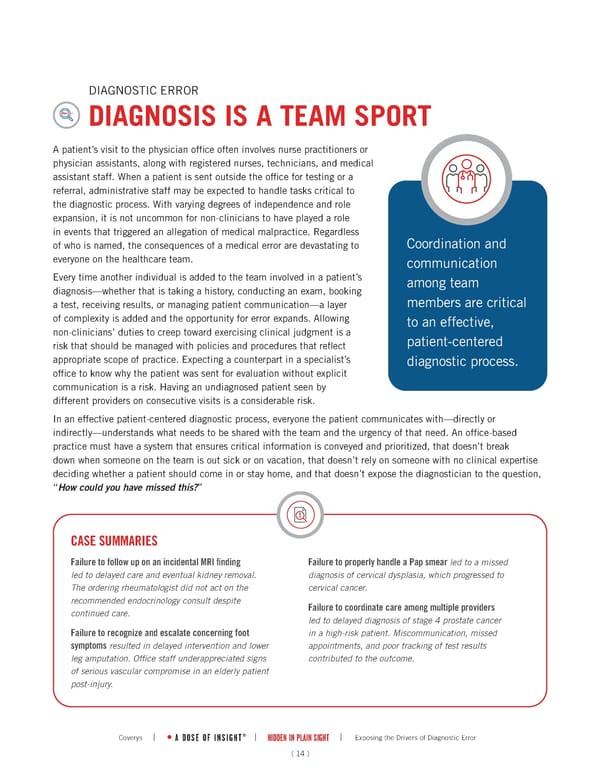DIAGNOSTIC ERROR DIAGNOSIS IS A TEAM SPORT A patient’s visit to the physician office often involves nurse practitioners or physician assistants, along with registered nurses, technicians, and medical assistant staff. When a patient is sent outside the office for testing or a referral, administrative staff may be expected to handle tasks critical to the diagnostic process. With varying degrees of independence and role expansion, it is not uncommon for non-clinicians to have played a role in events that triggered an allegation of medical malpractice. Regardless of who is named, the consequences of a medical error are devastating to everyone on the healthcare team. Every time another individual is added to the team involved in a patient’s diagnosis—whether that is taking a history, conducting an exam, booking a test, receiving results, or managing patient communication—a layer of complexity is added and the opportunity for error expands. Allowing non-clinicians’ duties to creep toward exercising clinical judgment is a risk that should be managed with policies and procedures that reflect appropriate scope of practice. Expecting a counterpart in a specialist’s office to know why the patient was sent for evaluation without explicit communication is a risk. Having an undiagnosed patient seen by different providers on consecutive visits is a considerable risk. In an effective patient-centered diagnostic process, everyone the patient communicates with—directly or indirectly—understands what needs to be shared with the team and the urgency of that need. An office-based practice must have a system that ensures critical information is conveyed and prioritized, that doesn’t break down when someone on the team is out sick or on vacation, that doesn’t rely on someone with no clinical expertise deciding whether a patient should come in or stay home, and that doesn’t expose the diagnostician to the question, “How could you have missed this?” ( 14 ) | HIDDEN IN PLAIN SIGHT | Exposing the Drivers of Diagnostic Error A DOSE OF INSIGHT ® Coverys | Coordination and communication among team members are critical to an effective, patient-centered diagnostic process. CASE SUMMARIES Failure to follow up on an incidental MRI finding led to delayed care and eventual kidney removal. The ordering rheumatologist did not act on the recommended endocrinology consult despite continued care. Failure to recognize and escalate concerning foot symptoms resulted in delayed intervention and lower leg amputation. Office staff underappreciated signs of serious vascular compromise in an elderly patient post-injury. Failure to properly handle a Pap smear led to a missed diagnosis of cervical dysplasia, which progressed to cervical cancer. Failure to coordinate care among multiple providers led to delayed diagnosis of stage 4 prostate cancer in a high-risk patient. Miscommunication, missed appointments, and poor tracking of test results contributed to the outcome.
 Hidden in Plain Sight: Exposing the Drivers of Diagnostic Error - PART II Page 14 Page 16
Hidden in Plain Sight: Exposing the Drivers of Diagnostic Error - PART II Page 14 Page 16